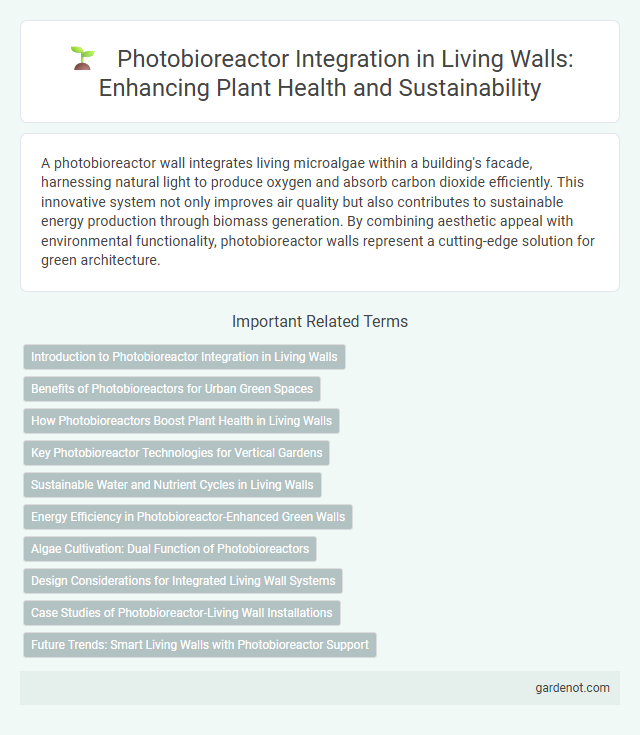A photobioreactor wall integrates living microalgae within a building's facade, harnessing natural light to produce oxygen and absorb carbon dioxide efficiently. This innovative system not only improves air quality but also contributes to sustainable energy production through biomass generation. By combining aesthetic appeal with environmental functionality, photobioreactor walls represent a cutting-edge solution for green architecture.
Introduction to Photobioreactor Integration in Living Walls
Photobioreactor walls integrate microalgae cultivation systems within living walls, enhancing air purification and carbon dioxide absorption while producing biomass for bioenergy. These systems optimize light exposure and nutrient distribution to promote efficient microalgal growth, contributing to sustainable building design and urban greening. Incorporating photobioreactors in living walls supports climate mitigation efforts by combining aesthetic greenery with renewable energy generation.
Benefits of Photobioreactors for Urban Green Spaces
Photobioreactor walls enhance urban green spaces by efficiently capturing carbon dioxide and producing oxygen through microalgae cultivation, improving air quality and reducing urban heat island effects. These living walls contribute to sustainable building practices by generating biomass for biofuel or bioproducts, promoting energy efficiency in dense city environments. Integration of photobioreactors supports biodiversity and provides aesthetic and environmental value, transforming urban landscapes into eco-friendly, productive ecosystems.
How Photobioreactors Boost Plant Health in Living Walls
Photobioreactor walls enhance plant health in living walls by providing optimized light and nutrient conditions through controlled algae cultivation, which produces oxygen and essential bioactive compounds. These systems improve air quality and promote photosynthesis, leading to more robust and resilient plant growth. The continuous interaction between algae and plants creates a sustainable microenvironment, reducing stress factors and boosting overall plant vitality.
Key Photobioreactor Technologies for Vertical Gardens
Photobioreactor walls utilize advanced microalgae cultivation systems, integrating transparent panels and optimized light distribution to support photosynthetic growth in vertical gardens. Key technologies include tubular, flat-panel, and thin-layer photobioreactors, each designed for efficient gas exchange, nutrient delivery, and biomass harvesting within urban environments. These systems enhance air purification, carbon capture, and aesthetic value while enabling sustainable vertical farming and green building applications.
Sustainable Water and Nutrient Cycles in Living Walls
Photobioreactor walls integrate microalgae cultivation to enhance sustainable water and nutrient cycles in living walls by recycling greywater and capturing carbon dioxide. This innovative system reduces reliance on external fertilizers through bio-nutrient regeneration while improving air quality via photosynthesis. Efficient water reuse and nutrient recovery support ecosystem balance and urban sustainability.
Energy Efficiency in Photobioreactor-Enhanced Green Walls
Photobioreactor-enhanced green walls significantly improve energy efficiency by harnessing microalgae's natural photosynthesis to regulate building temperatures and reduce HVAC loads. These living walls absorb CO2 while producing oxygen, contributing to better air quality and lowering carbon footprints. Integration of photobioreactors optimizes solar energy utilization, resulting in sustainable energy savings and enhanced thermal insulation for urban environments.
Algae Cultivation: Dual Function of Photobioreactors
Photobioreactor walls optimize algae cultivation by combining vertical farming with sustainable air purification, enhancing urban environments through carbon dioxide absorption and oxygen production. These systems utilize controlled light, temperature, and nutrient supply, maximizing photosynthetic efficiency and biomass yield. The dual function of photobioreactors supports renewable biofuel development and contributes to improved indoor air quality, making them a multifunctional solution for green architecture.
Design Considerations for Integrated Living Wall Systems
Photobioreactor walls require careful integration of algae cultivation within living wall systems to balance light exposure, humidity, and nutrient flow for optimal photosynthetic efficiency. Design considerations include selecting transparent, UV-resistant materials that facilitate maximum light penetration while ensuring structural support and water containment. Proper airflow management and temperature control are essential to maintain stable microclimates that promote algal growth without compromising plant health in adjacent living wall components.
Case Studies of Photobioreactor-Living Wall Installations
Photobioreactor living wall installations have demonstrated significant environmental benefits, including enhanced air quality and carbon dioxide reduction through microalgae cultivation. Case studies from urban centers like Singapore and Berlin highlight successful integration of photobioreactor systems into building facades, showcasing energy-efficient designs that promote biofuel production and sustainable architecture. These projects underline the potential of photobioreactor walls to transform urban spaces into climate-positive environments by combining biotechnological innovation with green building practices.
Future Trends: Smart Living Walls with Photobioreactor Support
Smart living walls integrated with photobioreactor technology represent a cutting-edge trend in sustainable architecture, enhancing air quality and energy efficiency by harnessing microalgae's photosynthetic capabilities. These walls optimize carbon dioxide absorption and oxygen generation, contributing to urban carbon capture and biofuel production. Future developments will emphasize AI-driven monitoring systems and adaptive light management to maximize photobioreactor productivity and ecosystem balance.
Photobioreactor wall Infographic

 gardenot.com
gardenot.com